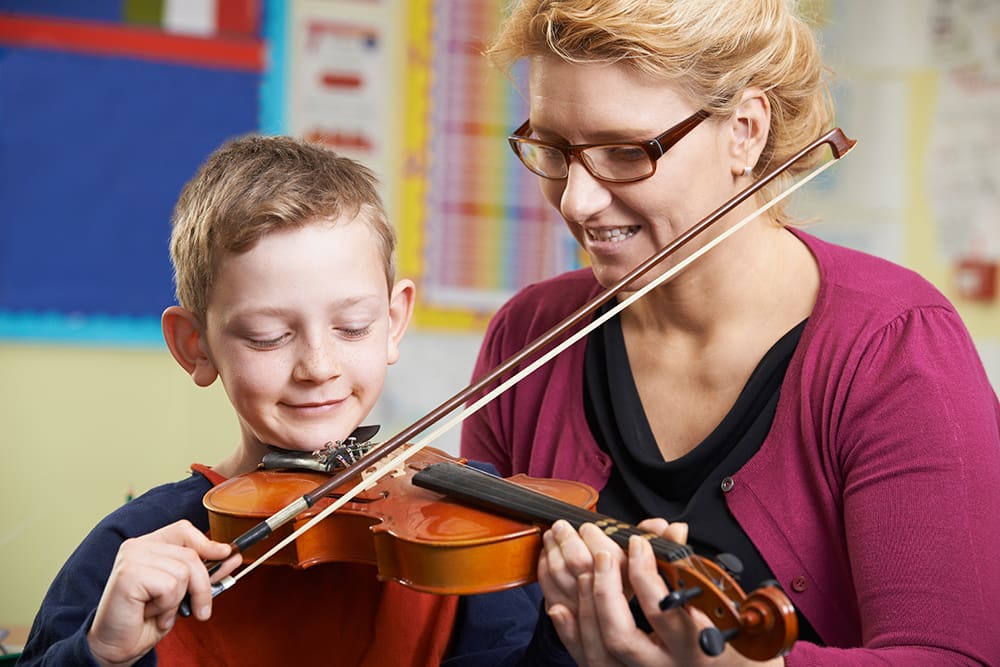I played sports growing up. I never showed any interest in learning to play an instrument, maybe it’s because my brother “played” the saxophone for less than a year. So, I wasn’t sure what to say when my fourth grader said, “I want to play the violin.”
I forced a smile on my face. You know. You’re supposed to support your kids when they want to try something new. I’m trying my best. I was surprised he wanted to play. Cohen doesn’t like to do much but play soccer, watch videos and play video games. But he insisted he wanted to learn to play, and all the child experts say it’s a good idea for kids to learn how to play an instrument. So I agreed.
The Beginnings of Violin Lessons
Free strings lessons are offered at our elementary school, beginning in fourth grade. So, we leased his first violin—a half-sized violin made for smaller hands. He had class once a week during school and practiced every day.
I’ll warn you now, as soon as you make the first payment on your child’s instrument, you will become insufferable. You will turn into an overbearing ogre who harbors some vague notion of propelling your young prodigy onto the stage of Carnegie Hall. You will make this happen through sheer willpower (i.e., screaming and threats); you will convince yourself this motivational tactic is not crazy behavior.
Learning to Play Songs
Every beginner violin player starts out by learning “Twinkle, Twinkle, Little Star.” You will get tired of listening to “Twinkle, Twinkle, Little Star” for 15 minutes every day.
You will say, “I bet this is how Lindsey Stirling started!” and “Good job! Your playing sounds a bit less like 30 cats in a fight today!”
“EEEEEEEEEE. EEEEE. EEEEE….RRRRRRR,” went his violin.
“Great job,” I said giving him a thumbs up.
So, even though he practiced at school, Cohen, being the video watcher that he is, of course YouTubed how to play the violin. So, instead of “Twinkle, Twinkle, Little Star,” I heard “Hot Cross Buns” and “Mary Had a Little Lamb.”
“EEEE. EEEEEEEE. RRRRRRR. EEEEE.”
“Great.” I put another smile on my face. I mean, he was learning. Down the line I imagine it’ll sound better.
Practice Makes Perfect
Cohen’s music teacher must be a saint. She gives kids a solid foundation. She works some crazy magic and makes 60 intermediate-beginner strings, woodwinds and brass musicians sound like the Boston Pops Orchestra….at least by the spring concert, I hope. You may need to strain your ears a bit to hear it during the early fall concert.
In the beginning, Cohen didn’t mind practicing. However, he would get tired of playing the same songs over and over, and I frankly got tired of listening. However, I paid for a violin, so he was going to play that violin. Even if he played while he was kicking and screaming!
Supporting Your Musician
Then one sunny day, without being asked Cohen picked up his violin and began playing on his own. Maybe it’s a sonata. Or maybe he’s noodling through a rough version of Lady Gaga’s “Poker Face” or the Sunday Night Football theme. I didn’t say a word. This is what I’ve been waiting for. I just kept doing the laundry and enjoyed the music.
Whether the lessons are initiated by me, his father, his music teacher or by Cohen himself, he is much more likely to be enthusiastic about them if those lessons are supported at home by my participation. I noticed that when music is a family value, kids learn to value it. Whether Cohen sits first chair in Carnegie Hall or he stops playing the violin after one year, music will stick with him throughout his life.

Mallory Connelly
Babies & Toddlers
In addition to the time I devote to being a mom, I also work full-time outside the home, which means my day is hardly ever as simple as nine to five. With an all-too-established schedule, as soon as I walk through the door, my day doesn’t end, but rather just begins. It’s a balancing act, especially with two children, but being a mom is one full-time job that I never want to quit!








